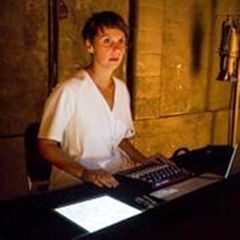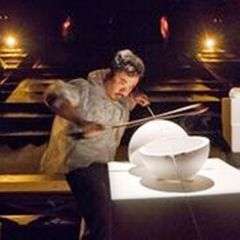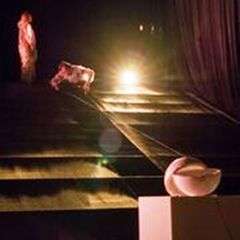|
Back
Rituals for a Godless Century New York
Gelsey Kirkland Academy
08/07/2018 - & August 8, 9, 2018
The Force of Things: An Opera for Objects (New York Premiere)
Ashley Fure (composer), Adam Fure (architect)
Members of International Contemporary Ensemble: Ross Karre (producer/percussionist), Levy Lorenzo (engineer/percussionist), Alice Teyssier and Lucy Dhegrae (voices), Ryan Muncy (saxophone), Rebekah Heller (bassoon), Dustin Donahue (percussion)
César Alvarez (dramaturg), Nicholas Houfek (lights), Patrick Eakin-Young

Composer A. Fure (© Richard Termine)
“There is geometry in the humming of the strings; there is music in the spacing of the spheres.”
Pythagoras (570-495 B.C.E)
Composer/sound-designer Ashley Fure has described her 55-minute The Force of Things: An Opera For Objects as transcending “the illusion of stasis”, her own inspiration “driven by a desire to tune our focus toward of rate of change and a scope of alteration at odds with the scale of human life.”
I prefer to called this a Mystery Play. In both senses of the word.
It was a mystery for the 120-odd people who crowded into an anteroom filled with huge parchments hanging from the ceiling. They resembled the kinds of parchment which those rabbis of Babylon used in transcribing the legends they remembered from Palestine. Or even more, the giant sheepskin coming from the Gargantuan herds of the Cyclops. In this room, we stood and turned around as different winds and inaudible sounds came from other places.
Nobody knew quite where to look.
The second mystery was when we were shuffled into the large theater to take backless seats, and we turned around and around again. The theater was dark except for two opposing platforms, upon which stood musicians fluttering plates, turning bowls. On one side was a bassoonist. The other had a saxophonist. They blended in with the sounds of two women whispering, breathing into ordinary megaphones. The mystery was where to look.
No acts were delineated, but Ms. Fure (with her architect brother Adam Fure) had created a black series of steps on the furthest end of the stage, On here was (what looked like) a zipline from top to the middle. And in the darkness (aside from stoplights,) a second ritual took place.
In fact, it was the ritual of any Mystery Play, where the musicians ascended and descended, until one of them descended to add to the humming and whispering, playing his bow on the zipline which was suspended on what looked like a giant egg.

D. Donahue, L. Lorenzo, R. Karre (© Richard Termine)
For the final section, all the performers came to a series of five vibrating cones, upon which ropes to the ceiling vibrated madly; and then stopped.
That mystery was over. We knew where to look. Finally.
The other meaning of Mystery Place could have (though I doubt if Ms. Fure would agree) referred to the medieval peasant meaning of the 12th Century dramas. In those originals, buffoonery, slapstick, pratfalls and silliness, were meant to transform the watchers into another world, a world away from disease, warfare and feudal punishments into a world of myth and laughter.
And then, hopefully, into a world of hope. (Paid for by moral contrition, and monetary contribution.)
In this case, Ashley and Adam Fure used no buffoonery (the artists, all dressed in plastic raincoats, were very very serious). But in these rituals of humming, whispering, ascents and descents, vibrations from electronic woofers, white sounds, black sounds, all in our godless 21Century equivalent of a black and shadowy eek or Christian temple, the composer obviously wanted us to pay attention to a different meaning and language.
The obvious avatar for this was of course Antonín Artaud, who wanted to transport us to worlds apart from our own with a new indecipherable language. But Artaud was a director and actor, not a composer or sound-designer. His “new” language was an archaic Balinese.
And I happen to know that not even the Balinese actors today have a clue what they are saying. Like choirboys intoning Latin or Bar Mitzvah boys reading phonetic Hebrew or village Mullahs in Tunisia reading ancient Arabic, the sounds themselves exalt us to another world.
Ms. Fure and her sterling musicians from International Contemporary Ensemble wanted us to soar into her own world, to “appreciate” objects turned sound.
That, of course depended on our personal moods. Bach and Schoenberg can take the most prosaic mood of the listener and raise it high. Ms. Fure needed us to go through the parchment-filled room and allow a religious transport.
In my case, that didn’t work. I happened to have loved every minute of The Force of Things. I loved the surprises, the disruptions, the assailments on our ears and (to a limited degree) our senses. I loved the idea of an audience turning hither and thither, and the auditory softs and louds rising and falling in the theater. And I loved, above all, the spectacle in the mystic darkness of the theater.

The ritual steps (© Richard Termine)
Though perhaps she didn’t quite make her point. This morning in my local park, a hawk sat for hours on a low-hanging branch, and I was as moved by this predatory bird as Ms. Fure’s inventions. My dog nosed another dog, who nosed him back, and their mutual tail-wagging caused me more visceral delight than this quite inspired work of art.
That, however, is not exactly apt. Far more appropriate is that the Fure’s, sœur et frère had created their own mini-universe. And for these mini-gods, we could delight, if not pay reverence, in their creation.
Harry Rolnick
|